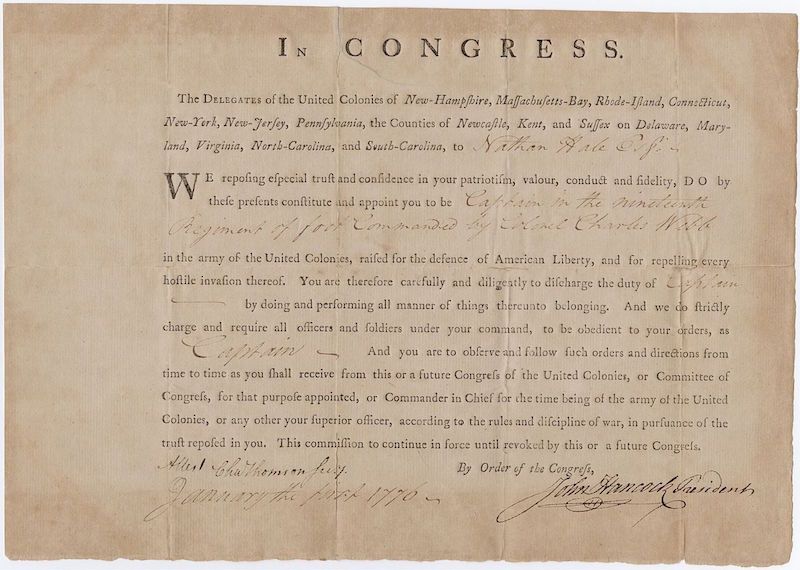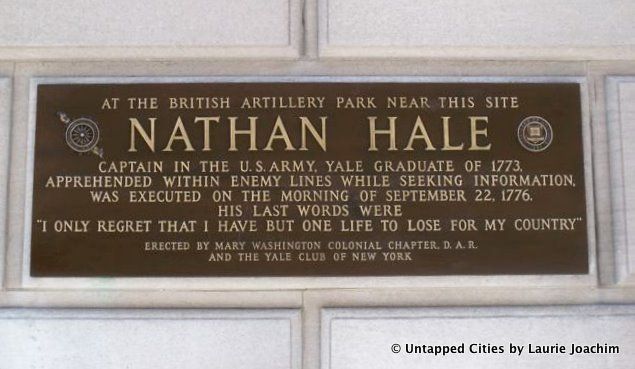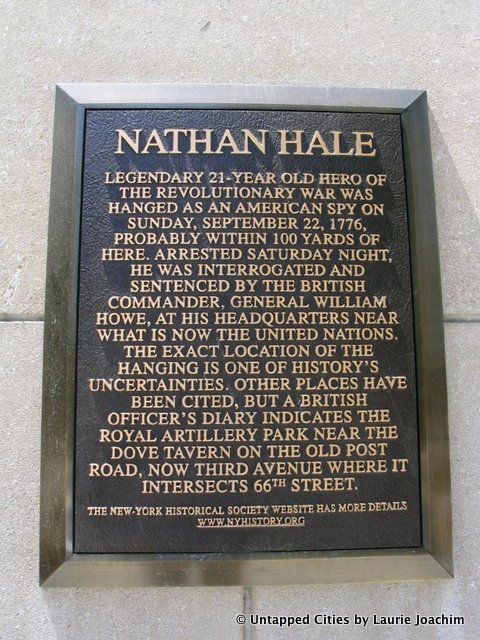A Salvaged Banksy Mural is Now on View in NYC
This unique Banksy mural goes up for auction on May 21st in NYC!


This image of Nathan Hale is viewable in City Hall Park on the Membit app. Membit is a new augmented reality app that gives you a way to share the past with the present and a way to share the present with the future. It’s so new it isn’t even in the App Store yet, it’s in beta. If you would like to try it out before everyone else, click here.
Untapped Cities is excited to announce our partnership with Membit, a geolocative photo sharing app that allows pictures to be placed and viewed in the exact location they were captured. Membit’s patented Human Positioning System (TM) allows for markerless Augmented Reality to be used anytime, anywhere, by anyone. We’ll be using Membit on our Throwback Thursday column (formerly This Week in NYC History), and we’ll be launching the technology in person at upcoming tours of the Remnants of Penn Station in October, part of a month-long programming that will culminate in a summit on the future of Penn Station at Cooper Union on November 2nd. We are working on this new tool from Columbia University’s GSAPP Incubator.
On September 22, 1776, Nathan Hale, legendary spy and American hero was executed by British forces in New York City.
After a miserable defeat at the Battle of Brooklyn, George Washington found himself stuck in Lower Manhattan and desperate for intelligence on the British army’s imminent invasion. He called for volunteers to gather information behind enemy lines on Red Coat positions and numbers. Nathan Hale, a Connecticut-born Yale grad and school teacher from the 7th Connecticut Regiment, was the only volunteer.

Nathan Hale’s commission as Captain in the 19th Regiment. From January 1, 1776 and complete with the John Hancock to beat all John Hancocks. Source: Wikipedia Commons.
On September 12, Hale was ferried over from Connecticut to Queens. Dressed as a simple school teacher, he began to gather information on British encampments and movements throughout the area. On September 15, the British finally invaded lower Manhattan driving Washington north to present-day Morningside Heights making Hale’s mission almost pointless. But Hale was cut off from communication with the Continental Army and decided to continue with his charge. While scouting out British barracks in Queens, Hale was noticed by British Major Robert Rogers who observed Hale walking back and forth on the coastal roads feverishly taking notes.
One night as Hale was resting in a local tavern, Rogers played the part of a beleaguered American militia man stuck behind enemy lines. Hale eventually confided in him that he was spying for Washington and Rogers, delighted that Hale took the bait, asked him to dine with him the next night to set the hook. Hale accepted and the next evening proceeded to tell Rogers every dirty detail. Rogers immediately arrested Hale, threw him on a sloop over the East River to the Commander of the British forces, General William Howe who was newly headquartered at Beekman House located around 50th and 51st streets between First and Second Avenues (Beekman Place).
Howe questioned Hale and found intelligence sketches on his person. The physical evidence was immediately damning and according to Howe, Hale sang like the proverbial canary. Howe reportedly detained Hale in a greenhouse next to Beekman House for the night where the prisoner requested both a Bible and a clergyman and was denied both. The next morning Howe hastily signed Hale’s execution order (since he had more important things to do… like finish taking over New York). As customary at the time, spies were hanged as illegal combatants thus Howe was within rights not to hold a trial for Hale.
Hale was marched up the Post Road to the Artillery Park (roughly 66th Street and Third Avenue) where he was hanged. It was reported that it took several agonizing minutes for Hale to die. Now for the famous last words: “I only regret that I have but one life to lose for my country,” Hale probably never said them. According to Alexander Rose in his book Washington’s Spies (the source for the AMC show TURN), those words were put into his mouth by his good Yale friend William Hull. The line itself was taken from a play by Joseph Addison called Cato.
“How beautiful is death, when earn’d by virtue!
Who would not be that youth? What pity is it
That we can die but once to serve our country.”
Apparently Hale had been taken with the play at Yale and Hull wanted assurances that history would remember his friend’s ultimate sacrifice.
His actual final moments where witnessed by a British Captain named Frederick MacKenzie who wrote in his diary on September 22 that:
“He behaved with great composure and resolution saying he thought it the duty of every good officer to obey any orders given to him by his commander in chief; and desired the spectators to be all times prepared to meet death in whatever shape it may appear.”
General Howe simply wrote in his diary:
“A spy from the enemy (by his own full confession) apprehended last night, was this day executed at 11 o’clock in front of Artillery Park.”
The British left his body to hang for days as a warning to any other rebels spying for Washington. A letter from a British officer in the Kentish Gazette from November of 1776 said:
“We hanged up a rebel spy the other day, and some soldier got, out of a rebel gentleman’s garden, a painted soldier on a board, and hung it along with the rebel; and wrote upon it, George Washington, and I saw it yesterday beyond headquarters by the roadside.”

The Nathan Hale statue in City Hall Park. The statue was designed by Stanford White in 1890 and was dedicated in 1893. It was moved from Broadway and Murray Streets to its current location in front of City Hall in 1999.
According to Rose, Hale’s body was dumped into a waiting unmarked grave somewhere near his hanging site and was never found. His family eventually erected an empty cenotaph to him up near his birthplace in South Coventry, CT.
Throughout the years there has been heated speculation as to the true location of Hale’s execution. Some claim it was in City Hall Park, then simply known as the Common. Others believed he was hung on the premises of today’s Grand Central Terminal while others say he was hanged on the current site of the Yale Club, which would be fitting because Hale is one of Yale’s most legendary graduates. You can see the plaques that make these claims below.

Plaque to Nathan Hale at the Yale Club of New York near Grand Central Terminal.

Plaque to Nathan Hale on 65th Street and 3rd Avenue
Hale was only 21 years old at the time of his death and quickly went on to become a historical legend. But his death had a much more immediate impact on the Revolution. Hale’s bravery went on to inspire Washington to create a full network of American spies whose efforts helped the Continental Army win the war.
Next, read about the spy ring that was created by Washington after the execution of Nathan Hale.
Subscribe to our newsletter